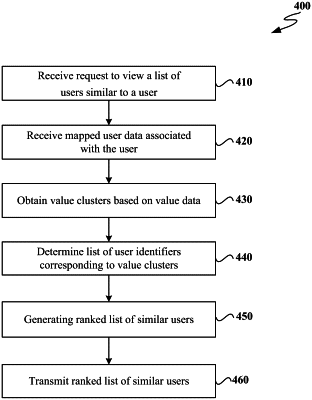| CPC G06F 16/9535 (2019.01) [G06F 16/90335 (2019.01); G06F 16/9035 (2019.01); G06F 16/906 (2019.01); G06N 3/04 (2013.01); G06N 3/088 (2013.01)] | 20 Claims |

|
1. A method for ranking users based on similarity, comprising:
receiving a request to view a list of users similar to a first user;
retrieving a first user identifier corresponding to mapped data for the first user;
determining, based on application context for the first user, that an application used by the user is a particular type of application of a plurality of different types of applications;
based on determining that the first user is part of a plurality of users, receiving a plurality of clusters of users based on mapped data of each of the plurality of users, wherein:
the plurality of clusters of users comprises a first cluster of users associated with the first user identifier, wherein the first cluster of users comprises the first user;
the plurality of clusters of users is generated based on operation of one or more machine learning models using the mapped data for the first user as input;
the one or more machine learning models comprise an autoencoder neural network that has been trained through an iterative learning process to generate an embedding of the mapped data; and
when comparing users to generate the plurality of clusters of users, user information that is related to the particular type of application is weighted more highly than other user information that is not related to the particular type of application;
locating the first cluster of users based on the first user identifier;
determining, based on the application context for the first user, a point of a flow of the application the first user has reached, wherein the application comprises a plurality of screens, and wherein the point of the flow of the application comprises a screen of the plurality of screens that the first user is currently viewing;
generating a ranked list of users similar to the first user based on the first cluster of users and the point of the flow of the application; and
transmitting the ranked list of users similar to the first user to a user device for display.
|